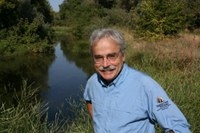Posts Tagged: Endangered Species Act
Of Presidents and Monarchs
Happy Presidents' Day. It's day we honor not only George Washington and Abraham Lincoln but all the men (no women yet!) who have served as President...

A monarch on the American flag. (Photo by Kathy Keatley Garvey)
Saving the Mojave desert tortoise
Saving the declining populations of Mojave desert tortoise is a big challenge. But scientists think that raising newborn “hatchling” tortoises in a controlled environment in the Mojave National Preserve for a year, then releasing the juvenile tortoises into the wild, may help save this threatened species.
The protected tortoises — which live up to 80 years and can go without water for a year — have existed for eons, but are now being decimated by habitat loss and predation. Professor Brian Todd, in the Department of Wildlife, Fish and Conservation Biology at UC Davis, worries that the increasing use of Southern California deserts for solar and wind energy, will add to the loss of tortoise habitats, and add further pressure to regional wildlife habitats. While developing renewable energy to combat climate change is a good thing, in this case it impacts desert species and their habitats.
Stepping up to the plate to save the Mojave desert tortoises is a triad of academics, government agencies, and corporations, who recently created the Ivanpah Desert Tortoise Research Facility. The new facility, located in the Mojave National Preserve, was designed for scientists to conduct research on juvenile tortoise survival. It was constructed largely by Chevron and Molycorp, and is managed by the National Park Service. Scientists from the University of California, University of Georgia, and elsewhere, are conducting a 15-year study to see if hatchlings released into the wild and/or relocated elsewhere can survive and reverse the population decline.
We can all keep our fingers crossed that this research will preserve desert tortoise populations, and serve as a model for conserving biodiversity.
Additional information:
- “Protecting the desert tortoise,” video of UC Davis researchers and desert tortoises.
- “Habitat selection, space use, and factors affecting recruitment of desert tortoises in the Mojave National Preserve”; Brian Todd website, UC Davis
- “Baby desert tortoises get a headstart in the Mojave,” by Andy Fell and Kat Kerlin, Egghead blog, UC Davis. With a video of tortoises and scientists.
- “Tortoise territory,” by Robin DeRieux, CA&ES Outlook magazine (see pages 2 and 10), UC Davis, spring/summer 2012.
- “Mojave National Preserve celebrates dedication of Ivanpah desert tortoise,” Mojave National Preserve website.
UC Davis scientists share perspectives on endangered species
You don't have to dig too deep into the scientific literature and popular media to find perspectives on threats posed to biodiversity in California and around the globe. Two UC Davis scientists in the Department of Wildlife, Fish and Conservation Biology have published fresh insights into endangered species in recent months.
Endangered Species Act sets a high standard
Peter Moyle, professor in the Department of Wildlife, Fish and Conservation Biology, is a renowned expert on California's native fish. He used the occasion of the 40th anniversary of the passage of the federal Endangered Species Act (ESA) in December 2013 to size up how the act influenced his own research and how some of California's aquatic biota have fared.
After passage of the ESA, Moyle and his graduate students initially searched for three species they suspected were in trouble: Modoc sucker, rough sculpin and bull trout. They found the sucker in trouble but easy to protect, the sculpin reasonably secure, and the bull trout near extinction in California. It has since vanished.
"As an untenured professor then, I thought it a bit risky to base a career on finding rare fish," Moyle wrote in an opinion piece published in The Sacramento Bee. “So I also undertook a study of Delta and longfin smelt, which at the time were two of the most abundant fish in the Sacramento–San Joaquin Delta.”
Moyle began a monthly sampling program to keep track of smelt populations and other fish in the Suisun Marsh. A few years later smelt counts dropped dramatically. The data eventually led to the U.S. Fish and Wildlife Service listing the Delta smelt as a “threatened” species under the ESA.
His ongoing research has recorded a statewide decline of most native fishes. With other researchers, Moyle has just completed detailed accounts of the biology and status of more than 60 native fishes — all potential candidates for ESA listings. This study will soon be released by the California Department of Fish and Wildlife.
“Most of our recommendations for preventing extinctions call for more and better water for the fish, or at least for protecting existing water they depend on,” Moyle said. “Funny how it almost always comes down to fish needing water.
“The Endangered Species Act sets a high standard in this regard because it not only forbids extinction; it also mandates recovery of each species to a more sustainable state.”
Moyle's opinion piece can be viewed in its entirety here.
Human longevity an indicator of endangered species
Aaron Lotz is a postdoctoral scholar who has previously worked with other UC Davis scientists in the development of conservation and management plans for reptiles and amphibians in California. Recently he was involved in a study published last fall in the journal Ecology and Society on the social and ecological predictors of global invasions and extinctions.
The researchers analyzed data from 100 countries, representing 87 percent of the world's population. They examined 15 social and ecological variables, such as tourism, per capita gross domestic product, water stress and political stability. The study showed that as human life expectancy increases, so does the percentage of invasive and endangered birds and mammals.
“It's not a random pattern,” Lotz said. “Out of all this data, that one factor — human life expectancy — was the determining factor for endangered and invasive birds and mammals.”
New Zealand, the United States and the Philippines had among the highest percentages of endangered and invasive birds. The study has been reported in the Los Angeles Times and other news media. Read more about the study's findings in our news release here. The journal article can be viewed here.






